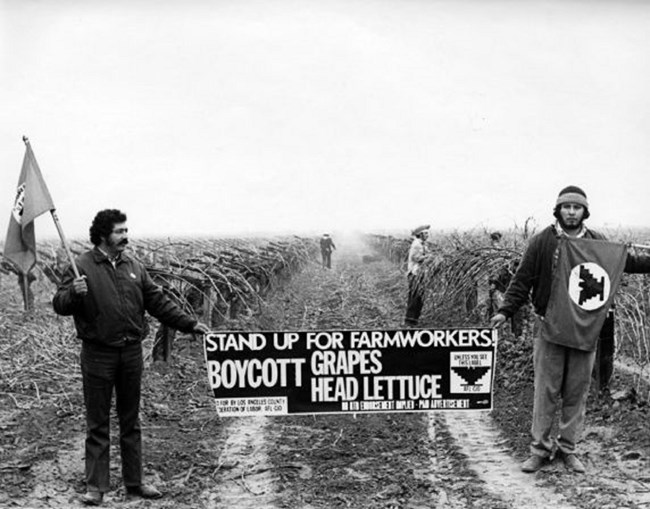Part of a series of articles titled The Road to Sacramento: Marching for Justice in the Fields.
Previous: Marching for Justice in the Fields
Article

Walter P. Reuther Library, Archives of Labor and Urban Affairs, Wayne State University.
Labor organizing has a long history in agriculture. This article explores efforts by farmworkers in California to form unions over roughly 30 years, from the New Deal to the 1960s. It also details the many challenges that impeded collection action.
A key provision of U.S. labor law, the National Labor Relations Act of 1935 (NLRA), guaranteed workers the right to join unions and collectively bargain through their representatives. It also restrained employers from interfering with unionization efforts or discriminating against union members. Nationwide, union membership exploded as a result of the NLRA, empowering workers suffering through the uncertainties of the Great Depression.
But farmworkers, along with domestic workers, had been explicitly excluded from the new labor law and the benefits it brought. Although farmworkers had been among those hardest hit by the Depression, the powerful farm bloc in Congress united with industrial interests to oppose the inclusion of farm workers in the NLRA. They argued that farmworker unions could potentially threaten the nation’s food supply and that higher wages would result in rising consumer prices for food and other basic commodities. The Fair Labor Standards Act (FLSA) of 1938, which established a federal minimum wage, overtime rules, and child labor prohibitions, also excluded agricultural labor from its provisions. As a result, farmworkers had no legal procedures or protections when it came to seeking collective bargaining rights or redress for wage and hour violations. Growers, in other words, had no obligation to recognize or negotiate with farmworker unions.
The exclusion of farm workers from the NLRA and other New Deal programs was deeply rooted in the racism that structured American society. It reinforced long standing disparities in economic and political power. Those left without workplace protections were disproportionately workers of color as industries and occupations not covered by the NLRA and FLSA had high numbers of Black, Mexican, and Filipino workers relative to their numbers in the U.S. population as a whole.
Despite these obstacles, farmworkers were not powerless. Lacking the protection of federal or state statutes, farmworkers instead relied on the power of protest to negotiate with their employers. The most common form of farmworker protest was the strike. By walking off the job, often at strategic moments right before a harvest, workers could exert economic pressure on growers, who risked the loss of an entire year’s investment if a crop was left to rot in the field.
Grapes, for example, must be harvested at their peak. Because the fruit does not continue to ripen after it is picked, timing is everything to ensure that it reaches the consumer at the optimal moment. Harvested too soon, the grapes are bitter and acidic. Left unharvested for too long, they spoil on the vine. To harvest correctly requires skilled labor, consisting of workers and crews with experience in the industry. By withdrawing their labor at key moments in the harvest, farmworkers could bring pressure to bear on the grape growers during wage negotiations. This leveled the playing field - to a degree - by forcing the growers to the bargaining table if they could not find adequate replacement labor in time to complete a harvest.
Using these tactics, farmworkers were sometimes successful in winning short-term gains, such as higher wages or better working or living conditions, at least for that season. This was especially true in the 1930s and 1940s, when some farmworkers successfully negotiated contracts with growers. The organizing victories of farmworkers during the Great Depression were all the more remarkable because they were achieved despite their exclusion from the labor legislation that had been so critical to the success of the broader labor movement in the United States. But without the legally protected right to organize, the farmworkers’ hard-won gained proved short-lived, their struggles beginning anew with every harvest.
Then, during World War II, a new challenge confronted America’s farm workers, setting back the pursuit of justice in the fields for decades. The Bracero Program was a series of agreements between the U.S. and Mexican governments to bring temporary guest workers from Mexico into the United States to fill vacancies in agricultural work.
Initially conceived to meet wartime production shortages, the Bracero Program continued well beyond the war’s end, depressing farm worker wages and presenting a serious obstacle to unionization. Many growers preferred to employ braceros, who were paid a fixed wage determined by federal officials, rather than negotiate with domestic workers who demanded a living wage. Because they were not U.S. citizens, braceros who protested wages or working conditions were especially vulnerable to deportation. Under the terms of the Bracero Program, growers could turn to a seemingly limitless supply of guest workers brought in by the federal government with little worry about labor laws or protections. This negatively affected the wages and working conditions of guest workers like braceros and domestic workers alike. Challenging this system would require years of cooperative efforts by farmworkers and their allies.
Bibliography
Bardacke, Frank. Trampling out the Vintage : Cesar Chavez and the Two Souls of the United Farm Workers. New York: Verso, 2011.
Cohen, Deborah, and ProQuest. Braceros Migrant Citizens and Transnational Subjects in the Postwar United States and Mexico. Chapel Hill: University of North Carolina Press, 2011.
Galarza, Ernesto. Farm Workers and Agri-business in California, 1947-1960. Notre Dame: University of Notre Dame Press, 1977.
McWilliams, Carey. Factories in the Field : The Story of Migratory Farm Labor in California. Berkeley, California: University of California Press, 2000.
Part of a series of articles titled The Road to Sacramento: Marching for Justice in the Fields.
Previous: Marching for Justice in the Fields
Last updated: March 20, 2025